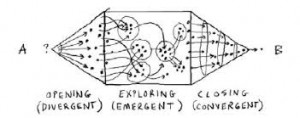Gamestorming
The purpose of is to get the participants to enter a ‘different space separate from reality.’ Below is a Sample Game Storming Session Outline;
What is Game Storming?
The purpose of Game Storming is to get the leadership team to enter a ‘different space separate from reality.’ It is designed to pull together the Visual, Audio, Kineasthetic and Read/Write creative skills that have been developed as part of the development process.
Every game evolves in stages, as follows; imagine the world, create the world, open the world, explore the world, and close the world.

Gamestorming aims to create game worlds specifically to explore and examine business challenges, to improve collaboration, and to generate novel insights about the way the world works and what kinds of possibilities we might find there – in other words different strategic possibilities.
Gamestorming is a useful technique that breaks down barriers, improves communication and helps to generate new ideas, insights and strategies.
Every game evolves in stages, as follows; imagine the world, create the world, open the world, explore the world, and close the world. Gamestorming aims to create game worlds specifically to explore and examine business challenges, to improve collaboration, and to generate novel insights about the way the world works and what kinds of possibilities we might find there – in other words different .
Gamestorming is a useful technique that breaks down barriers, and helps to generate new ideas, insights and strategies.
Gamestorming Session
Opening Remarks
Give an overview of the organisational situation, the reason for the intervention and some key outputs from the Diagnostic Phase
Fire Starting Challenge Question
e.g. How does the team engage with the global business?
How does the organisation future proof itself against a negative and declining market outlook?
Artefacts & Node Generation
Refer to previous outputs from the Diagnostic and other Interventions. Tangible, revisiting information of current situation and retelling the Story of Organisation Strategy
Post Up
As participants to generate Ideas of changes that need to happen, ask them to write on cards their thoughts in regards to the question and post them on the board.
Navigating Questions if Things get stuck
- Are we on track?
- Did I understand this correctly?
- Is this helping us get where we want to go?
- Is this a useful discussion thread?
- Should we table this for now and put it on a list of things to talk about later?
Randomness, Reversal and Reframing to invite new thinking.
Explain we seek and find patterns everywhere we look. We are so good at finding patterns that once we find one, it can be very difficult to see anything else.
Creating randomness is a way of fooling the mind so that you can more easily search for new patterns in familiar domains. By shuffling the deck, reversing the order or reframing the familiar, you create enough space for new ideas and opportunities to emerge. For example;
- Select three cards at random for each participant and ask them to draw ONE picture of an animal that represents all three ideas.
- Select one card at random for each participant and ask them to rewrite it from the opposite perspective
- Reshuffle all the cards taken from the wall, and redistribute them to the participants asking them to write one word that springs to mind.
Examining Questions
- What is it made of?
- How does it work?
- What are the pieces and parts
- Can you give me an example of that?
- What does that look like?
- Can you describe it in terms of a real life scenario?
Discuss these Questions
- What are the key points that stand out of me? Why?
- What are the most surprising points?
- How do I feel about what I have heard?
- What do I think are the most crucial data that the organisation should pay attention to?
Affinity Mapping & Role Play
Ask the groups to report what they have heard using the board stick their answers on.
When everyone has reported, facilitate a whole group conversation on the four questions above. The aim is for the group to come to some agreement on what to do next
Experimental Questions
- What else works like this?
- If this was an animal, what kind of animal would it be why?
- What are we missing?
- What if all the barriers were removed?
- How would we handle this if we were operating a restaurant?
- What if it was a hospital?
- What if we are wrong?
Improvisation – open path to new ideas, new practices and new behaviours.
To improvise is to make it up as you go along, to make do with whatever happens to be available, to proceed without a plan. Like a jazz musician, you compose and create at simultaneously.
When you improvise, you create in the moment, responding intuitively to the environment and your inner feelings, you let go. By letting go of your assumptions and biases, you open a path to new ideas, new practices, and new behaviours. You consciously forget what you know in order to elicit spontaneity, serendipity and surprise.
Take the team to the improvisation desk and give them 15 minutes to create a model of the organisation based on the firestarter question
Selection
People vote on the areas that actions would be required as they emerged from the discussion and how best to tackle them
Try Something New
People decide which action area they want to work on and discuss how they will begin.

